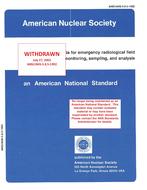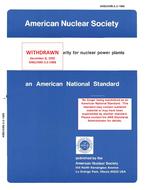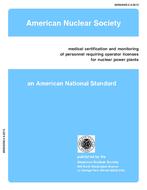-
-
Available Formats
- Availability
- Priced From ( in USD )
-
Available Formats
-
- Secure PDF 🔒
- Immediate download
-
$80.00Members pay $72.00
- Add to Cart
-
- Printed Edition
- Ships in 1-2 business days
-
$80.00Members pay $72.00
- Add to Cart
-
- Printed Edition + PDF
- Immediate download
-
$108.00Members pay $97.20
- Add to Cart
Customers Who Bought This Also Bought
-

ANS 3.8.5-1992
Priced From $77.00 -

ANS 3.8.7-1998
Priced From $87.00 -

ANS 3.3-1988
Priced From $107.00 -

ANS 3.4-2013 (R2023)
Priced From $189.00
About This Item
Full Description
This standard provides criteria for industrial security programs to protect operational nuclear power plants from acts of industrial sabotage that could lead to a threat to the health and safety of the public. Owner organizations may have other strong incentives for protection of nuclear power plants, such as protection of employees and the large capital investment involved, or the preservation of reliable power sources. Although these other incentives are recognized to have significant impact in the preparation of security programs, and may derive collateral support from the provisions of this standard, they were not considered explicitly in the preparation of the standard.
Specific provisions of industrial security programs must be regarded as highly sensitive information. For that reason, and because the security program for any plant must be carefully tailored to the unique characteristics and demands associated with that plant, this standard does not set forth a specific plan nor designate the degree to which specific protective measures should be incorporated into the overall industrial security program. Instead, important aspects of security planning are discussed individually. These aspects should all be considered in a deliberately planned and carefully and consistently executed program for each nuclear power- plant. The detailed combination of the several aspects must be balanced against the unique needs of each plant.
A suitably comprehensive industrial security program comprises those measures taken to thwart attempted sabotage. Means to accomplish this purpose include measures to control entry to the plant site or portions of the plant and to deter or discourage penetration by unauthorized persons, to detect such penetrations in the event they occur, to apprehend in a timely manner unauthorized persons or authorized persons acting in a manner constituting a threat of sabotage, and to provide for appropriate authorities to take custody of violators. The means by which such measures are implemented generally fall into five major subject areas, each of which is discussed in subsequent sections of this standard: (1) physical and administrative control of access to the plant site or portions thereof; (2) selecting and retaining reliable personnel and detecting aberrant behavior; (3) monitoring the status of vital equipment and facilities; ( 4) augmenting security in the event of actual or potential threats to plant security; and (5) design features of the 'plant specifically provided for security purposes and design features (such as location of the site, separation and redundancy of vital equipment, shielding of radiation sources or containment structures) provided for reasons that may or may not be associated with security but which reduce the vulnerability of the plant to sabotage attempts.
A key ingredient of any successful industrial security program is a well-motivated and alert operating staff. The technical competence of personnel selected for assignment to a nuclear power plant is the subject of American National Standard for the Selection and Training of Personnel for Nuclear Power Plants, NlB.1-1971. Although the criteria set forth in NIB.1-1971 do not address the security consciousness aspect of motivation, the caliber of personnel normally selected to meet the requirements of that standard is such that orientation on security matters is generally well received by the staff. Owner organizations should establish and maintain an ongoing program to foster and enhance the security awareness of the staff.
Planning for industrial security should provide flexibility to respond to a wide variety of potential threats. In preparing this standard, specific consideration was given to potential threats posed by: (1) a single disgruntled employee who is authorized to have access to the plant and who is familiar with the details of construction and operation of the plant; (2) a single fanatic or mentally deranged person, either an authorized employee or an outsider, whose knowledge of the plant may range from none to intimate familiarity; (3) a small group of discordant individuals, not normally authorized access to the plant, who are intent on perpetrating acts of sabotage or seizing control of the plant; and (4) spontaneous and undisciplined actions of a relatively large group of people involved in mob activities associated with acts of civil disturbance. Although it is clear that other potential threats may exist or develop, conscientious application of measures designed to protect against the threats discussed above will provide substantial protection against other postulated threats.
Planning for the industrial security program should be initiated during the design of the plant; the program shall be implemented no later than the commencement of fuel loading. Special provisions required to prevent compromise of the industrial security program during construction of adjacent units or facilities may be necessary. It is not practical to include major construction activities within a protected area. Multiunit plants that will have one unit in operation while construction continues on the other units require special consideration. The protected areas of operating units and their associated operating facilities shall use temporary physical barriers, as required, to effectively isolate them from construction areas before fuel loading for their operation begins.
Protection against actions associated with deliberate assaults by trained para-military groups or military units of a foreign power is not covered by this standard. Protection against such actions. is the responsibility of the U.S. Government. The U.S. Atomic Energy Commission (AEC) promulgates regulations applicable to many aspects of design, construction, operation, and administration of nuclear power plants. The criteria provided in this standard are intended to be consistent with applicable AEC criteria, including those given in the Code of Federal Regulations, Title 10, Part 50, 10 CFR 50. This standard shall not take precedence over any AEC regulations.





